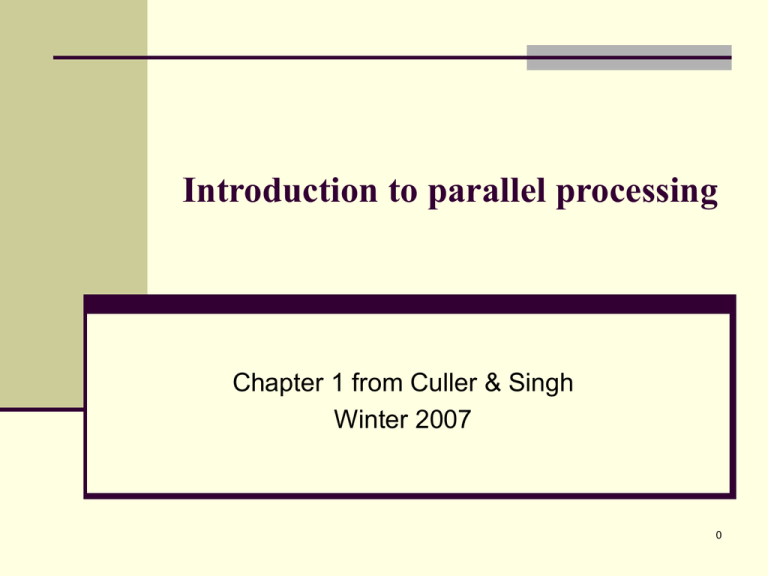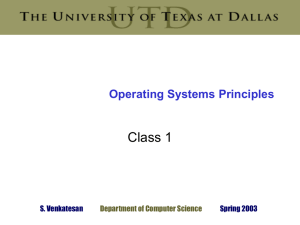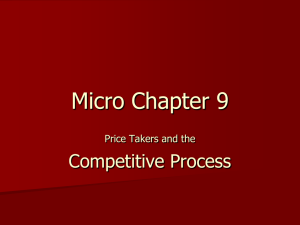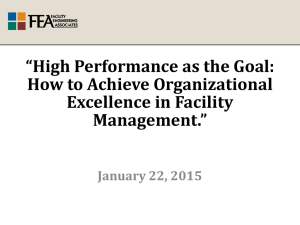High-Performance Computer Architecture
advertisement

Introduction to parallel processing Chapter 1 from Culler & Singh Winter 2007 0 Introduction What is Parallel Architecture? Why Parallel Architecture? Evolution and Convergence of Parallel Architectures Fundamental Design Issues Winter 2007 ENGR9861 R. Venkatesan High-Performance Computer Architecture 1 What is Parallel Architecture? A parallel computer is a collection of processing elements that cooperate to solve large problems fast Some broad issues: Resource Allocation: Data access, Communication and Synchronization how do the elements cooperate and communicate? how are data transmitted between processors? what are the abstractions and primitives for cooperation? Performance and Scalability Winter 2007 how large a collection? how powerful are the elements? how much memory? how does it all translate into performance? how does it scale? ENGR9861 R. Venkatesan High-Performance Computer Architecture 2 Why Study Parallel Architecture? Role of a computer architect: To design and engineer the various levels of a computer system to maximize performance and programmability within limits of technology and cost. Parallelism: Winter 2007 Provides alternative to faster clock for performance Applies at all levels of system design Is a fascinating perspective from which to view architecture Is increasingly central in information processing ENGR9861 R. Venkatesan High-Performance Computer Architecture 3 Why Study it Today? History: diverse and innovative organizational structures, often tied to novel programming models Rapidly maturing under strong technological constraints The “killer micro” is ubiquitous Laptops and supercomputers are fundamentally similar! Technological trends cause diverse approaches to converge Technological trends make parallel computing inevitable In the mainstream Need to understand fundamental principles and design tradeoffs, not just taxonomies Winter 2007 Naming, Ordering, Replication, Communication performance ENGR9861 R. Venkatesan High-Performance Computer Architecture 4 Application Trends Demand for cycles fuels advances in hardware, and vice-versa Cycle drives exponential increase in microprocessor performance Drives parallel architecture harder: most demanding applications Range of performance demands Need range of system performance with progressively increasing cost Platform pyramid Goal of applications in using parallel machines: Speedup Speedup (p processors) = Performance (p processors) Performance (1 processor) For a fixed problem size (input data set), performance = 1/time Time (1 processor) Speedup fixed problem (p processors) = Winter 2007 ENGR9861 R. Venkatesan High-Performance Computer Architecture Time (p processors) 5 Scientific Computing Demand Winter 2007 ENGR9861 R. Venkatesan High-Performance Computer Architecture 6 Engineering Computing Demand Large parallel machines a mainstay in many industries, for example, Winter 2007 Petroleum (reservoir analysis) Automotive (crash simulation, drag analysis, combustion efficiency), Aeronautics (airflow analysis, engine efficiency, structural mechanics, electromagnetism), Computer-aided design Pharmaceuticals (molecular modeling) Visualization in all of the above entertainment (films like Shrek 2, The Incredibles) architecture (walk-throughs and rendering) Financial modeling (yield and derivative analysis). ENGR9861 R. Venkatesan High-Performance Computer Architecture 7 Applications: Speech and Image Processing 10 GI PS 1 GIP S Te lephone Num ber Rec ognition 100 MIP S 10 MI PS 1 MIP S 1980 200 Words Isolate d Spee ch Rec ognition Sub-Band Spe ec h Coding 1,000 Words Continuous Spe ec h Rec ognition 5,000 Words Continuous Spe ec h Rec ognition HDTVRec e ive r CIF Video ISDN-CD Stere o Rec eive r CELP Spe ec h Coding Spe aker Ve ri¼c ation 1985 1990 1995 • Also CAD, Databases, . . . • 100 processors gets you 10 years! Winter 2007 ENGR9861 R. Venkatesan High-Performance Computer Architecture 8 Learning Curve for Parallel Applications AMBER molecular dynamics simulation program Starting point was vector code for Cray-1 145 MFLOP on Cray90, 406 for final version on 128-processor Paragon, 891 on 128-processor Cray T3D Winter 2007 ENGR9861 R. Venkatesan High-Performance Computer Architecture 9 Commercial Computing Also relies on parallelism for high end Scale not so large, but use much more wide-spread Computational power determines scale of business that can be handled Databases, online-transaction processing, decision support, data mining, data warehousing ... TPC benchmarks (TPC-C order entry, TPC-D decision support) Winter 2007 Explicit scaling criteria provided Size of enterprise scales with size of system Problem size no longer fixed as p increases, so throughput is used as a performance measure (transactions per minute or tpm) ENGR9861 R. Venkatesan High-Performance Computer Architecture 10 Summary of Application Trends Transition to parallel computing has occurred for scientific and engineering computing In rapid progress in commercial computing Database and transactions as well as financial Usually smaller-scale, but large-scale systems also used Desktop also uses multithreaded programs, which are a lot like parallel programs Demand for improving throughput on sequential workloads Greatest use of small-scale multiprocessors Solid application demand exists and will increase Winter 2007 ENGR9861 R. Venkatesan High-Performance Computer Architecture 11 Technology Trends Performance 100 Supercomputers 10 Mainframes Microprocessors Minicomputers 1 0.1 1965 1970 1975 1980 1985 1990 1995 The natural building block for multiprocessors is now also about the fastest! Winter 2007 ENGR9861 R. Venkatesan High-Performance Computer Architecture 12 General Technology Trends Microprocessor performance increases 50% - 100% per year Transistor count doubles every 3 years DRAM size quadruples every 3 years Huge investment per generation is carried by huge commodity market Not that single-processor performance is plateauing, but that parallelism is a natural way to improve it. 180 160 140 DEC alpha 120 100 80 60 40 20 MIPS Sun 4 M/120 260 MIPS M2000 IBM RS6000 540 Integer FP HP 9000 750 0 1987 Winter 2007 1988 1989 1990 1991 1992 ENGR9861 R. Venkatesan High-Performance Computer Architecture 13 Technology: A Closer Look Basic advance is decreasing feature size ( ) Circuits become either faster or lower in power Die size is growing too Clock rate improves roughly proportional to improvement in Number of transistors improves like (or faster) Performance > 100x per decade; clock rate 10x, rest transistor count How to use more transistors? Parallelism in processing Proc $ Locality in data access multiple operations per cycle reduces CPI avoids latency and reduces CPI also improves processor utilization Interconnect Both need resources, so tradeoff Fundamental issue is resource distribution, as in uniprocessors Winter 2007 ENGR9861 R. Venkatesan High-Performance Computer Architecture 14 Clock Frequency Growth Rate Clock rate (MHz) 1,000 100 10 R10000 Pentium100 i80386 i80286 i8086 1 i8080 i8008 i4004 0.1 1970 1980 1990 2000 1975 1985 1995 2005 • 30% per year Winter 2007 ENGR9861 R. Venkatesan High-Performance Computer Architecture 15 Transistor Count Growth Rate • 100 million transistors on chip by early 2000’s A.D. • Transistor count grows much faster than clock rate - 40% per year, order of magnitude more contribution in 2 decades 100,000,000 Transistors 10,000,000 1,000,000 100,000 i80286 R10000 Pentium i80386 R3000 R2000 i8086 10,000 i8080 i8008 i4004 1,000 2000 1990 1980 1970 2005 1995 1985 1975 Winter 2007 ENGR9861 R. Venkatesan High-Performance Computer Architecture 16 Storage Performance Divergence between memory capacity and speed more pronounced Capacity increased by 1000x from 1980-2005, speed only 5x 4 Gigabit DRAM now, but gap with processor speed much greater Larger memories are slower, while processors get faster Need to transfer more data in parallel Need deeper cache hierarchies How to organize caches? Parallelism increases effective size of each level of hierarchy, without increasing access time Parallelism and locality within memory systems too New designs fetch many bits within memory chip; follow with fast pipelined transfer across narrower interface Buffer caches most recently accessed data Disks too: Parallel disks plus caching Winter 2007 ENGR9861 R. Venkatesan High-Performance Computer Architecture 17 Architectural Trends Architecture translates technology’s gifts to performance and capability Resolves the tradeoff between parallelism and locality Current microprocessor: 1/3 compute, 1/3 cache, 1/3 off-chip connect Tradeoffs may change with scale and technology advances Understanding microprocessor architectural trends Helps build intuition about design issues or parallel machines Shows fundamental role of parallelism even in “sequential” computers Four generations of architectural history: tube, transistor, IC, VLSI Here focus only on VLSI generation Greatest delineation in VLSI has been in type of parallelism exploited Winter 2007 ENGR9861 R. Venkatesan High-Performance Computer Architecture 18 Architectural Trends in VLSI Greatest trend in VLSI generation is increase in parallelism Up to 1985: bit level parallelism: 4-bit -> 8 bit -> 16-bit slows after 32 bit adoption of 64-bit now under way, 128-bit far (not performance issue) great inflection point when 32-bit micro and cache fit on a chip Mid 80s to mid 90s: instruction level parallelism pipelining and simple instruction sets, + compiler advances (RISC) on-chip caches and functional units => superscalar execution greater sophistication: out of order execution, speculation, prediction to deal with control transfer and latency problems 2000s: Thread-level parallelism Winter 2007 ENGR9861 R. Venkatesan High-Performance Computer Architecture 19 ILP Ideal Potential 3 25 2.5 20 2 Speedup Fraction of total cycles (%) 30 15 1.5 10 1 5 0.5 0 0 0 1 2 3 4 5 6+ Number of instructions issued 0 5 10 15 Instructions issued per cycle • Infinite resources and fetch bandwidth, perfect branch prediction and renaming – real caches and non-zero miss latencies Winter 2007 ENGR9861 R. Venkatesan High-Performance Computer Architecture 20 Raw Uniprocessor Performance: LINPACK 10,000 CRAY s CRAY Micro Micro 1,000x1000 matrix 100 x 100 matrix 1,000x1000 matrix 100 x 100 matrix LINPACK (MFLOPS) 1,000 T94 s C90 s s 100 s Ymp Xmp/416 s DEC 8200 IBM Power2/990 MIPS R4400 Xmp/14se DEC Alpha HP9000/735 DEC Alpha AXP HP 9000/750 s CRAY 1s IBM RS6000/540 10 MIPS M/2000 MIPS M/120 Sun 4/260 1 1975 Winter 2007 1980 1985 1990 1995 ENGR9861 R. Venkatesan High-Performance Computer Architecture 2000 21 Summary: Why Parallel Architecture? Increasingly attractive Economics, technology, architecture, application demand Increasingly central and mainstream Parallelism exploited at many levels Instruction-level parallelism Multiprocessor servers Large-scale multiprocessors (“MPPs”) Focus of this class: multiprocessor level of parallelism Same story from memory system perspective Increase bandwidth, reduce average latency with many local memories Wide range of parallel architectures make sense Different cost, performance and scalability Winter 2007 ENGR9861 R. Venkatesan High-Performance Computer Architecture 22 History of parallel architectures Historically, parallel architectures tied to programming models Divergent architectures, with no predictable pattern of growth. Uncertainty of direction paralyzed parallel software development! Application Software Systolic Arrays Dataflow Winter 2007 System Software Architecture SIMD Message Passing Shared Memory ENGR9861 R. Venkatesan High-Performance Computer Architecture 23 Today’s architectural viewpoint Architectural enhancements to support communication and cooperation OLD: Instruction Set Architecture NEW: Communication Architecture Defines Critical abstractions, boundaries, and primitives (interfaces) Organizational structures that implement interfaces (h/w or s/w) Compilers, libraries and OS are important bridges today Winter 2007 ENGR9861 R. Venkatesan High-Performance Computer Architecture 24 Modern Layered Framework CAD Database Multiprogramming Shared address Scientific modeling Message passing Data parallel Compilation or library Operating systems support Communication hardware Parallel applications Programming models Communication abstraction User/system boundary Hardware/software boundary Physical communication medium Winter 2007 ENGR9861 R. Venkatesan High-Performance Computer Architecture 25 Programming Model What programmer uses in coding applications Specifies communication and synchronization Examples: Multiprogramming: no communication or synch. at program level Shared address space: like bulletin board Message passing: like letters or phone calls, explicit point to point Data parallel: more regimented, global actions on data Winter 2007 Implemented with shared address space or message passing ENGR9861 R. Venkatesan High-Performance Computer Architecture 26 Communication Abstraction User level communication primitives provided Realizes the programming model Mapping exists between language primitives of programming model and these primitives Supported directly by HW, or via OS, or via user SW Lot of debate about what to support in SW and gap between layers Today: HW/SW interface tends to be flat, i.e. complexity roughly uniform Compilers and software play important roles as bridges today Technology trends exert strong influence Result is convergence in organizational structure Relatively simple, general purpose communication primitives Winter 2007 ENGR9861 R. Venkatesan High-Performance Computer Architecture 27 Communication Architecture Comm. Arch. = User/System Interface + Implementation User/System Interface: Comm. primitives exposed to user-level by HW and system-level SW Implementation: Organizational structures that implement the primitives: HW or OS How optimized are they? How integrated into processing node? Structure of network Goals: Performance Broad applicability Programmability Scalability Low Cost Winter 2007 ENGR9861 R. Venkatesan High-Performance Computer Architecture 28 Evolution of Architectural Models Historically machines tailored to programming models Prog. model, comm. abstraction, and machine organization lumped together as the “architecture” Evolution helps understand convergence Identify core concepts Shared Address Space Message Passing Data Parallel Others: Dataflow Systolic Arrays Examine programming model, motivation, intended applications, and contributions to convergence Winter 2007 ENGR9861 R. Venkatesan High-Performance Computer Architecture 29 Shared Address Space Architectures Any processor can directly reference any memory location Communication occurs implicitly as result of loads and stores Convenient: Location transparency Similar programming model to time-sharing on uniprocessors Except processes run on different processors Good throughput on multiprogrammed workloads Naturally provided on wide range of platforms History dates at least to precursors of mainframes in early 60s Wide range of scale: few to hundreds of processors Popularly known as shared memory machines or model Ambiguous: memory may be physically distributed among processors Winter 2007 ENGR9861 R. Venkatesan High-Performance Computer Architecture 30 Shared Address Space Model Process: virtual address space plus one or more threads of control Portions of address spaces of processes are shared Virtual address spaces for a collection of processes communicating via shared addresses Load P1 Machine physical address space Pn pr i v at e Pn Common physical addresses P2 P0 St or e Shared portion of address space Private portion of address space P2 pr i vat e P1 pr i vat e P0 pr i vat e Writes to shared address visible to other threads (in other processes too) Winter 2007 Natural extension of uniprocessors model: conventional memory operations for comm.; special atomic operations for synchronization OS uses shared memory to coordinate processes ENGR9861 R. Venkatesan High-Performance Computer Architecture 31 Communication Hardware in SAS arch. Also natural extension of uniprocessor Already have processor, one or more memory modules and I/O controllers connected by hardware interconnect of some sort I/O devices Mem Mem Mem Interconnect Processor Mem I/O ctrl I/O ctrl Interconnect Processor Memory capacity increased by adding modules, I/O by controllers Winter 2007 Add processors for processing! For higher-throughput multiprogramming, or parallel programs ENGR9861 R. Venkatesan High-Performance Computer Architecture 32 History of SAS architectures Mainframe” approach Motivated by multiprogramming Extends crossbar used for mem bw and I/O Originally processor cost limited to small P P later, cost of crossbar Bandwidth scales with p High incremental cost; use multistage instead I/ O C I/ O C M M M M “Minicomputer” approach Almost all microprocessor systems have bus Motivated by multiprogramming, TP Used heavily for parallel computing Called symmetric multiprocessor (SMP) Latency larger than for uniprocessor Bus is bandwidth bottleneck Winter 2007 caching is key: coherence problem I/ O I/ O C C M M $ $ P P Low incremental cost ENGR9861 R. Venkatesan High-Performance Computer Architecture 33 Example of SAS: Intel Pentium Pro Quad CPU P-Pro module 256-KB Interrupt L2 $ controller Bus interface P-Pro module P-Pro module PCI bridge PCI bus PCI I/O cards PCI bridge PCI bus P-Pro bus (64-bit data, 36-bit address, 66 MHz) Memory controller MIU 1-, 2-, or 4-way interleaved DRAM All coherence and multiprocessing glue in processor module Highly integrated, targeted at high volume Low latency and bandwidth Winter 2007 ENGR9861 R. Venkatesan High-Performance Computer Architecture 34 Example of SAS: SUN Enterprise P $ P $ $2 $2 CPU/mem cards Mem ctrl Bus interface/switch Gigaplane bus (256 data, 41 address, 83 MHz) I/O cards High-Performance Computer Architecture SBUS SBUS 2 FiberChannel processors + memory, or I/O All memory accessed over bus, so symmetric Higher bandwidth, higher latency ENGR9861 R. Venkatesan Winterbus 2007 SBUS 16 cards of either type: 100bT, SCSI Bus interface 35 Scaling Up SAS Architecture M M M Net work $ $ $ M $ M $ P P P P P “Dance hall” M $ P Distributed memory latencies to memory uniform, but uniformly large Distributed memory or non-uniform memory access (NUMA) Problem is interconnect: cost (crossbar) or bandwidth (bus) Dance-hall: bandwidth still scalable, but lower cost than crossbar Net work Construct shared address space out of simple message transactions across a general-purpose network (e.g. read-request, read-response) Caching shared (particularly nonlocal) data? Winter 2007 ENGR9861 R. Venkatesan High-Performance Computer Architecture 36 Example scaled-up SAS arch. : Cray T3E Scale up to 1024 processors, 480MB/s links Memory controller generates comm. request for nonlocal references No hardware mechanism for coherence (SGI Origin etc. provide this External I/O P $ Mem Mem ctrl and NI XY Switch Z Winter 2007 ENGR9861 R. Venkatesan High-Performance Computer Architecture 37 Message Passing Architectures Complete computer as building block, including I/O Communication via explicit I/O operations Programming model: directly access only private address space (local memory), comm. via explicit messages (send/receive) High-level block diagram similar to distributed-memory SAS But comm. integrated at IO level, needn’t be into memory system Like networks of workstations (clusters), but tighter integration Easier to build than scalable SAS Programming model more removed from basic hardware operations Winter 2007 Library or OS intervention ENGR9861 R. Venkatesan High-Performance Computer Architecture 38 Message-Passing Abstraction Match ReceiveY, P, t AddressY Send X, Q, t AddressX Local process address space ProcessP Process Q Send specifies buffer to be transmitted and receiving process Recv specifies sending process and application storage to receive into Memory to memory copy, but need to name processes Optional tag on send and matching rule on receive User process names local data and entities in process/tag space too In simplest form, the send/recv match achieves pairwise synch event Local process address space Other variants too Many overheads: copying, buffer management, protection Winter 2007 ENGR9861 R. Venkatesan High-Performance Computer Architecture 39 Evolution of Message-Passing Machines Early machines: FIFO on each link Hw close to prog. Model; synchronous ops Replaced by DMA, enabling non-blocking ops Buffered by system at destination until recv Diminishing role of topology Store&forward routing: topology important Introduction of pipelined routing made it less so Cost is in node-network interface Simplifies programming 100 101 000 001 110 111 011 Winter 2007 ENGR9861 R. Venkatesan High-Performance Computer Architecture 010 40 Example of MP arch. : IBM SP-2 Power 2 CPU IBM SP-2 node L2 $ Memory bus General interconnection network formed fr om 8-port switches 4-way interleaved DRAM Memory controller MicroChannel bus I/O DMA i860 NI DRAM NIC Made out of essentially complete RS6000 workstations Network interface integrated in I/O bus (bw limited by I/O bus) Winter 2007 ENGR9861 R. Venkatesan High-Performance Computer Architecture 41 Example Intel Paragon i860 i860 L1 $ L1 $ Intel Paragon node Memory bus (64-bit, 50 MHz) Mem ctrl DMA Driver Sandia’ s Intel Paragon XP/S-based Super computer 4-way interleaved DRAM 2D grid network with processing node attached to every switch Winter 2007 NI ENGR9861 R. Venkatesan High-Performance Computer Architecture 8 bits, 175 MHz, bidirectional 42 Toward Architectural Convergence Evolution and role of software have blurred boundary Send/recv supported on SAS machines via buffers Can construct global address space on MP using hashing Page-based (or finer-grained) shared virtual memory Hardware organization converging too Tighter NI integration even for MP (low-latency, high-bandwidth) At lower level, even hardware SAS passes hardware messages Even clusters of workstations/SMPs are parallel systems Emergence of fast system area networks (SAN) Programming models distinct, but organizations converging Nodes connected by general network and communication assists Implementations also converging, at least in high-end machines Winter 2007 ENGR9861 R. Venkatesan High-Performance Computer Architecture 43








